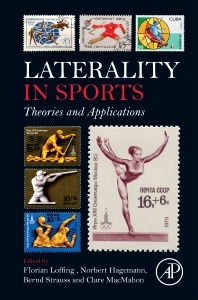Laterality in Sports Theories and Applications
Coordonnateurs : Loffing Florian, Hagemann Norbert, Strauss Bernd, MacMahon Clare

Laterality in Sports: Theories and Applications summarizes recent research on the neurophysiological foundations of handedness, and how left or right lateralization (affecting primary hand use, foot use, and eye use) affects motor control, performance outcome, skill acquisition, and achievement of sports expertise?both for one-on-one sports and team sports. As laterality research has matured, greater focus has been given to applications in human endeavours and, in particular, sport. The book examines performance within individual sports, and discusses the coaching ramifications of coaching to a specific lateralization preference.
1. Laterality in Sports: More Than Two Sides of the Same Coin
Section A. Laterality – An Important and Often Disregarded Topic 2. Origins, Development, and Persistence of Laterality in Humans 3. In Fencing, Are Left-Handers Trouble for Right-Handers? What Fencing Masters Said in the Past and What Scientists Say Today 4. Measurement of Laterality and Its Relevance for Sports 5. Laterality and Its Role in Talent Identification and Athlete Development 6. Perspectives From Sports Medicine
Section B. Motor Control and Learning 7. What Can We Learn About Cognition From Studying Handedness? Insights From Cognitive Neuroscience 8. Laterality of Basic Motor Control Mechanisms: Different Roles of the Right and Left Brain Hemispheres 9. Effector Transfer 10. Near Misses and the Effect of Attentional Asymmetries on Sporting Performance
Section C. Performance in Sports 11. Laterality in Individualized Sports 12. Performance Differences Between Left- and Right-Sided Athletes in One-on-One Interactive Sports 13. Biomechanical Considerations of Laterality in Sport 14. Laterality Effects on Performance in Team Sports: Insights From Soccer and Basketball 15. Skill Acquisition in Left- and Right-Dominant Athletes: Insights From Elite Coaching
Norbert Hagemann is currently Full Professor for Sport Psychology at the University of Kassel (Germany). He received his PhD from the University of Muenster for his thesis “Heuristic problem solving strategies of team coaches. Prof. Hagemann is studying the cognitive processes underlying how athletes perform in training and competitive situations. The focus is particularly on their perception and attention processes. Prof. Hagemann has been working on the topic of laterality for several years. This research has been supported by several research grants from the German Research Foundation. He publishes and reviews regularly papers in high-impact international peer-reviewed Journals.
Bernd Strauss, born 1959, is currently Full Professor for Sport Psychology at the University of Muenster, Germany (since 1998). He obtained his PhD from the University of Kiel (Germany) in 1992 with a thesis about complex problem solving. He had been the former president of the German Society of Sport Sciences (2003-2009). Currently he is president of the German Sport Psychology association. Bernd Strauss published more than 20 books, and more than 70 peer-reviewed papers. Currently he i
- Describes the neurophysiological foundations of handedness
- Discusses the origins and development of laterality in humans
- Summarizes the impact of laterality on motor control and sports performance
- Encompasses research on both individual and team sports
- Includes research on skill acquisition, coaching, and development of expertise
- Covers research on laterality in preferred hand, foot, and eye use in sports
Date de parution : 08-2016
Ouvrage de 380 p.
15x22.8 cm
Thèmes de Laterality in Sports :
Mots-clés :
Asymmetry; Attention; Baseball; Bilateral practice; Bilateral; Brain lateralization; Cerebral lateralization; Coach; Combat stance; Constraints; Cycling; Decision-making; Development; Dimensionality; Dopamine level; Dynamic movement sequences; Earedness; Edinburgh Handedness Inventory; Effector transfer; Elbow; Embodied cognition; Evolution; Expertise; Eyedness; Feedback; Fencing; Fighting hypothesis; Fitness cost; Footedness; Fossil hominins; Frequency-dependency; Frequency-dependent selection; Gymnastics; Handedness polymorphism; Handedness; Hemispheric asymmetry; Heritability; History; Implicit motor learning; Innate superiority; Interactive sports; Isokinetic; Kicking; Latent class analysis; Lateral preference; Laterality assessment; Laterality; Lateralization; Learning; Left-handedness; Limb dominance; Line bisection; Manual asymmetry; Memory; Mental simulations; Motor asymmetry; Motor coding; Muscular strength; Negative frequency-dependent selection; Observational learning; Online control; Perception; Perceptual-cognitive processing; Preference patterns; Preplanned control; Pseudoneglect; Range of motion; Rasch measurement; Rotational preference; Running; Shoulder; Sidedness; Skill learning; Sport; Sport-specific laterality; Strategic advantage; Symmetry; Tactics; Talent; Tennis; Throwing; Training effects; Vestibular asymmetry; Visual anticipation; Visual-spatial coding



